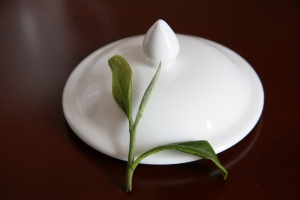BOOK REVIEW
by Mary Lou Heiss
November 8, 2015
The Book of Tea
by Okakura Kakuzo
Tuttle Publishing (December 15, 1989)

In Kakuzo Okakura’s eloquently conceived discourse, The Book of Tea, Okakura introduces readers to the intricacies of Japanese culture and values. Okakura arrived in America in 1905 and took a position in the Chinese and Japanese Department of the Boston Museum of Fine Arts which he held until his death in 1913. He was also associated with the Isabella Stewart Gardner Museum and was influential in assisting Mrs.Gardner amass a stunning collection of Asian art. In fact, Kakuzo Okakura made Boston the center of the late-nineteenth-century vogue in the United States for art and objects Japanese.
The Book of Tea was first published in 1906, and has remained in publication continuously since. Okakura chose to write his book in English for an American audience. His intent was that his words act as a cultural emissary and spread understanding and appreciation for Japanese art and culture to an American audience that little understood Japanese culture. For most Westerners, Japan remained an aloof place with intriguing customs and impeccable taste.
With thoughtful and beautifully crafted sentences delivered in a straightforward and direct manner, Okakura chose to write about Japanese culture via the Japanese tea ceremony – Chanoyu – using this topic as the vehicle to explore his subject and give voice to his words and feelings. Perhaps by drawing on the tea drinking sensibilities of New Englanders, he chose this way to approach his objective of introducing and clarifying essential Japanese beliefs on topics such as life, art, religion, spirituality, and the value of beauty. He also paved the way for an appreciation of Japanese tea culture that reverberates to this day.
The roots of tea culture began in Japan during the Nara Period (710-794). By the Muromachi Period (1333-1573) Zen Buddhist practices were firmly established in Japan. The great Japanese tea masters, such as Sen Rikyu, were Zen masters who shaped these doctrines and embraced tea drinking as a disciplined ritual central to developing the mental and physical health necessary to lead an ordered and practical life.
Tea drinking underscored Zen concepts and incorporated the principles of
wa (harmony), kei (respect), sei (purity) and jaku (tranquility) – virtues that imbued meaning not just to the lives of individuals, but also to society at large thru mindful and respectful social interactions. Undertaken as a mindful ritual, tea drinking embraced spiritual ideals, philosophical thinking and cultural values. It provided the opportunity for men and women of all walks of life to kneel as equals beside one another in the simple and pure environment of the tea room.
By focusing their attention on the details involved in the preparation and enjoyment of the tea, guests could leave behind the worries of their everyday existence and take pleasure in the humble beauty of the experience.
Okakura titles his chapters The Cup of Humanity, The Schools of Tea, Taoism and Zennism, The Tea-Room, Art Appreciation, Flowers, and Tea Masters, all of which combines into a skillful, parallel walk thru the ideals of chanoyu and Zen approaches to life.






